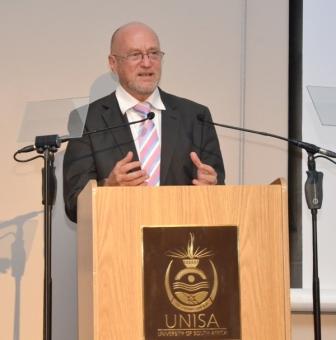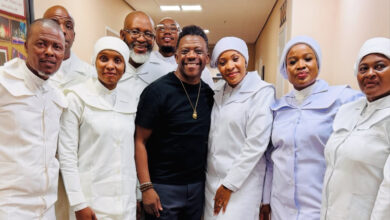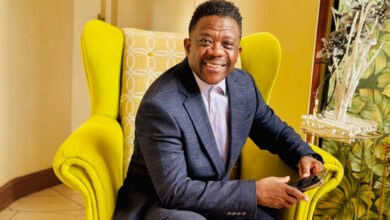UNISA Science campus opening – Minister Hanekom’s speech

KEYNOTE ADDRESS BY THE MINISTER OF SCIENCE AND TECHNOLOGY, DEREK HANEKOM, AT THE NATIONAL LAUNCH OF THE UNIVERSITY OF SOUTH AFRICA SCIENCE CAMPUS, FLORIDA ON 30 JULY 2013
Programme Director; Professor Phakeng;
Vice Chancellor of the University of South Africa, Professor Mandla Makhanya;
Pro Vice Chancellor of the University of South Africa, Professor Narend Baijnath;
Other members of the University Executive Management;
Educators and learners;
Distinguished guests;
In 2010, a Ministerial Review Committee was appointed to respond to a few critical questions: Is South Africa’s science, technology and innovation landscape ready to meet the needs of the country? Is the country making optimal use of its existing strengths in the National System of Innovation? Is the country positioned to respond rapidly to a changing global context and to meet the knowledge needs of the country in the coming 10 to 30 years?
One of the key recommendations of the Review Committee was the establishment of a high-level, multi-stakeholder body that would be responsible for coordination and coherence in the National System of Innovation.
So just over a week ago, I convened the Science, Technology and Innovation Summit, attended mainly by board chairs and heads of science councils, heads of parastatals and leaders of industry. The summit provided a valuable forum for robust discussions and reflection on the opportunities and challenges in achieving a focussed, aligned and more effective system of research, development and innovation.
Panellists were asked what should be the one non-negotiable for our government when it draws up its budget; and speaker after speaker said that government, private sector, academia and civil society ought to prioritise the whole value chain of education.
Knowledge generation is the very foundation of our National System of Innovation. It gives me pleasure then to join the UNISA family here today to celebrate the official opening of this quite remarkable campus and UNISA’s commitment to supporting and improving not just the practice of science and technology in South Africa, but South Africa’s continued innovation thrust.
An innovation instinct has been part of UNISA’s DNA from the time it became the country’s first examining university in 1918, and launched, amidst tremendous controversy, the Division of External Studies for correspondence study in 1944, to form a dedicated distance education institution that would serve both educational and social development needs. And now UNISA is using open distance e-learning to make studying, most often restricted to brick and mortar laboratories and lecture theatres, available to students whose circumstances would otherwise preclude a career in science and technology.
The ability to sustain pioneering initiatives in education for almost a century in such a way is truly remarkable. Such passion for quality education will inevitably transmit itself to the students who will study through this campus.
Ladies and gentleman, few people fully appreciate the toil and investment that goes into science and the generation of knowledge. It is science that enables us to understand that the closest living relative of the hippo is the whale. On the surface of it, this may not seem like an important fact. Looked at more deeply, one realises that the science behind the fact is all about DNA, genetics, the evolution of species, conservation, and, ultimately restoring and maintaining the ecological balance of our planet. Understanding the relationship between hippos and whales may help us deal with global warming and make the planet more sustainable. Indirectly, it will save human life.
Science is about asking the questions ‘why’ and ‘how’. It’s about curiosity and observation. And it’s about communication.
The skilled teaching and training of mathematics, chemistry, physics and all their related subjects is a vital ingredient to our county’s advancement in scientific areas. Our colleagues at the Department of Basic Education and our various private and public partners – are pouring tremendous human and financial resources into putting the infrastructure and facilities in place to enable such teaching.
Facilities such as this one, with its environmental sensitivity, embody and exemplify the effort that players in the science and technology sector are putting into catalysing South African innovation.
But, without passion – in our teachers and our students, and in the sector as a whole – we’re not going to get an acceptable return on the resources and effort being ploughed in. If South Africans see and do science and technology as a necessity rather than revelling in it for its own sake, we’re not going to blaze trails as a country. We’ll be technicians, not leaders. We’ll be consumers of other people’s innovation rather than creating and dominating markets of our own.
The problem is, of course, that you can’t teach passion. But you can create the environment in which it can blossom. To do that, you have to be passionate yourself. You have to want to share your love of what you do; to give other people a chance to experience the same exhilaration of exploration through research, of creating through innovation something that wasn’t there before, of making the world a safer, cleaner, happier place because you asked either the question ‘why?’ or the question ‘why not?’.
What is so gratifying about today, for me, is to see that this Unisa Science Campus is such passion made visible. The buildings have been constructed on green principles. The design and technology that has gone into them is innovation at its practical and sustainable best.
Beyond that, however, is the commitment and dedication within government to enabling science and technology advancement in South Africa and, therefore, not just providing the funding, through the Department of Higher Education and Training, for the establishment of the campus but also having the insight into the innovation involved as well as the will and wisdom to encourage its implementation. Beaurocrats are often accused of being unimaginative, and frightened of change. I don’t see any evidence of that here!
And that’s going to give a tremendous boost to the ability of the Department of Science and Technology to fund and direct research and human capital development in a strategic and co-ordinated manner. I am confident that one day soon, this campus will be a beneficiary of the DST’s research chairs programme.
But, the significance of this campus goes well beyond even these achievements. I said earlier that, for South Africans to revel in science and technology, they have to feel part of the excitement of exploration, of discovery, and of change.
The process of naming the buildings on this campus does just that. The process was made inclusive by inviting the university community and South African society at large to submit suggestions for names – thereby demonstrating that scientific endeavour can be an inclusive and participatory process and how it is possible to link African tradition and modern science.
I don’t envy Unisa’s Naming of Buildings Committee the task of choosing names from the 1, 055 suggestions that were put forward! But I do congratulate Unisa as a whole on its commitment to the African way – of consultation – and for using technology, via the Internet, to generate enthusiasm within society for an institution of science and technology.
It goes without saying, also, that Unisa’s astute decision to hold the official opening of this campus during National Science Week will draw the attention of students and educators alike, further embedding the positive idea of an exciting career in science and technology into the country’s awareness.
The campus also points to the potential for a curriculum to be developed for the effective communication of science. Because of the inclusive and environmentally sensitive way campus facilities have been conceived and built, the campus’ rare ability to extend education to students in remote and rural areas, and the integrated way in which the campus intends to apply science and technology in education to fulfil the research, development, and innovation needs of the country, it inherently communicates much of the passion and enthusiasm and commitment needed to get South Africans interested in science.
I would like to see that mature and innate understanding of communication captured and distilled into a formal science communication curriculum – or science and society studies – to equip future scientists and technologist to market and communicate the value of their work.
In the absence of dedicated programmes aimed at bridging the gap between science and society, we will remain with a weak science awareness and engagement programme in the country. Our scientists generally lack the skills to interact with journalists and use the media as an effective avenue to keep communities abreast of scientific and technological developments. Journalists too, require training to research and write science stories better.
Currently, the Department supports over 30 science centres and six national research facilities are involved in science awareness and engagement work. Staff in these institutions rely mainly on sharing experiences, as there are no institutions in the country to provide them with formal training on science communication.
It goes without saying, therefore, that training in science communication and awareness studies will assist enormously in this task and in developing a nation that values and appreciates science and technology.
I conclude with a quotation from Albert Einstein that I used at the STI Summit that I spoke about earlier:
“To raise new questions, new possibilities, to regard old problems from a new angle, requires creative imagination and marks real advance in science”.
The opening of this building demonstrates the creative imagination that Einstein was celebrating. May this building also mark such a real advance in delivering new scientists for South Africa and Africa.
Thank you.





